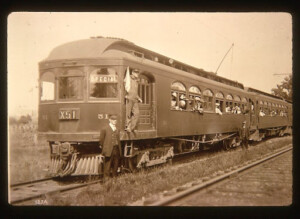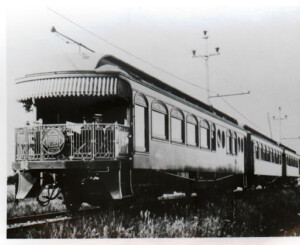Origins of the Oregon Electric Railway
Let’s turn our clocks back to the end of the first decade of the 20th century.
The run from Portland to Salem, and possibly even Eugene–and back, along the route of the new Oregon Electric Railway, was one of the symbols of the new economic explosion that has hit Oregon.
Excitement still was in the Oregon air from the Lewis and Clark Exposition in Portland in 1905 that triggered these boom times.
We hear about how the 21st century, will be the “Century of the Pacific.” The economies of the Pacific Rim countries are booming and Oregon is sharing in that upsurge.
At the beginning of the 20th century, our forefathers were convinced that the century now ending would be “America’s Pacific Century.” They had good reason to think so. With the Panama Canal nearly completed, with Hawaii and the Philippines in our sphere of influence, the United States was becoming a Pacific power. The “Open Door to China” policy promised to create a market for our goods.
It was in the euphoria of these times that leaders in the City of Portland, still shaking itself free from its pioneer and frontier image, decided to launch the most ambitious project in the State’s history, an international exposition centered around the 100th anniversary of the Lewis and Clark Expedition of 1804-1806. I ts theme was “Westward The Course of Empire Takes Its Way.”
President Theodore Roosevelt tapped a golden telegraph key in the White House on June 1, 1905 to set off chimes in the U. S. Government Pavilion to officially open the fair. Predictions of a million visitors to the fair were exceeded by more than half. The fair brought more than money and people to Oregon, it brought a change of attitude in the people who lived here.
Preparations for the fair required long-range planning. Design of the Exposition site was done by the firm that created Central Park in New York City. Portlanders approved bond issues to launch a master plan of parks for the city.
A surge of hotel and office building accompanied the Exposition. In the aftermath of the fair, Portland doubled its population to 200,000 and predictions of a million or more were common.
The boom opened Eastside Portland to spreading subdivisions. In the 40 years prior to the fair, street and sewer expansion in Portland cost $8,000,000. In the 10 years after the fair, it totaled $28,000,000.
It is in this atmosphere, then, that you stamp your feet impatiently at the Oregon Electric station at 10th and Hoyt in downtown Portland, just up the street from the magnificent Union Railway Station, ready to begin your run south, up the Willamette Valley. Good luck!
Compiled and written by Wes Sullivan, 1998
Bibliography:
The following are the principal sources from which the information was gathered:
Oregon Geographic Names, by Lewis A. McArthur, Fifth Edition Oregon, End of the Trail, by WPA workers, compiled in 1940. In search of Western Oregon, by Ralph Friedman Railroading in the Lower Willamette Valley, Robert Lowry et al Portland, Gateway to the Northwest, by Carl Abbott. The Great Extravaganza, by Carl Abbott. The Story of Eugene, by Lucia Moore et al.
The primary source of information about the Oregon Electric Railroad and Oregon railroading in general was Edwin D. Culp of Salem. Ed Culp’s book, “Stations West, the Story of the Oregon Railways,” has a fine chapter on the Oregon Electric. The book led to Ed himself and to his treasure house of information and memorabilia about Oregon railroads. The photographs, the original tickets, the advertisements all helped to provide a clearer, more colorful picture of the Oregon Electric and its times.
Also, my thanks to my former colleague at the Statesman Journal in Salem, Al Jones, for his counsel.
This article originally appeared on the original Salem Online History site and has not been updated since 2006.









Leave A Comment